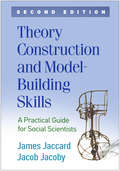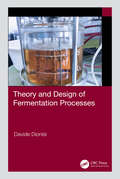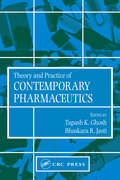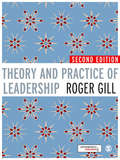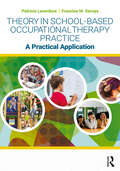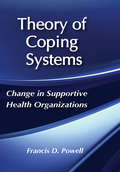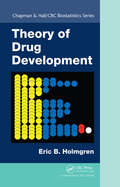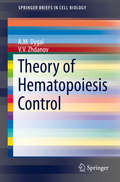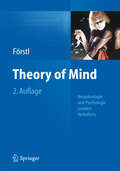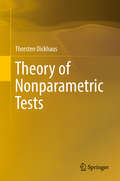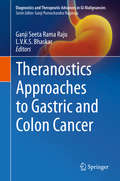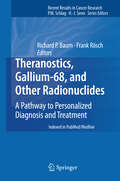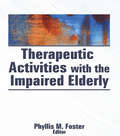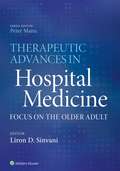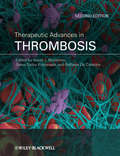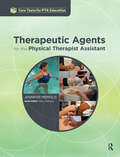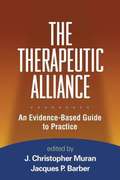- Table View
- List View
Theory & Practice of Therapeutic Massage, Sixth Edition
by Mark F. BeckTheory & Practice of Therapeutic Massage is full of invaluable knowledge and fundamental concepts for learning massage. The text also provides introductions into several areas within the profession, with chapters devoted to spa massage, lymph massage, clinical massage techniques, therapeutic procedure, athletic massage, and massage in medicine.
Theory And Practice Of Therapeutic Massage Workbook (Sixth Edition)
by Mark F. BeckThis Theory & Practice of Therapeutic Massage Workbook has been written to meet the needs, interests, and abilities of students, like you, receiving training In therapeutic massage. This workbook should be used together with Theory & Practice of Therapeutic Massage, Sixth Edition.
Theory Construction and Model-Building Skills, Second Edition: A Practical Guide for Social Scientists (Methodology in the Social Sciences)
by James Jaccard Jacob JacobyThis accessible, hands-on text has now been revised and updated, with expanded coverage of topics including how theory may emerge from exploratory data analysis. The book prepares graduate students, new researchers, and even seasoned investigators to develop their own theories and build on existing ones. Concrete strategies are provided to help readers generate ideas, define constructs, and think through relationships and processes that link constructs. Compelling examples from multiple disciplines illustrate the use of quantitative, qualitative, and mixed methods orientations to theory construction. The text also offers practical advice for writing effectively about theories in papers and grant applications. Readers learn by doing via application and concept exercises, demonstration boxes, and practical guidelines. The extensive companion website includes (www.theory-construction.com) PowerPoint slides of all of the book&’s figures, primers on advanced topics, video demonstrations, supplemental exercises, and other resources. New to This Edition *Emergent theory is now covered in mixed methods as well as qualitative approaches, plus in a new chapter on exploratory quantitative methods that can help generate new theory through data mining. *Chapter on whether and how to revise a theory when faced with disconfirmatory data. *Two chapters on the theoretical underpinnings of measurement practices. *New or expanded discussions of what constitutes a theoretical contribution, conceptual logic models, thought experiments, and more. Pedagogical Features *Application and concept exercises in every chapter. *Lists of key terms and engaging topical boxes. *Annotated suggestions for further reading. *New companion website with rich resources for students and instructors. *Chapters stand on their own and can be used in any order.
Theory and Design of Fermentation Processes
by Davide DionisiThe book covers the kinetics and design of fermentation processes, defined in the broader sense as any industrial processes that use living microorganisms or cells, both under aerobic and anaerobic conditions. It starts with a concise introduction to microbes and their metabolism, followed by rate equations, stoichiometry, derivation and use of mass balances for the design processes. It covers oxygen transfer and mass balances, heat transfer and design and scale-up/scale-down of fermentation processes. It further includes industrially relevant process examples, over 100 solved examples, questions and problems, and solutions of differential equations and systems of equations in Excel. Features Uses chemical engineering principles for the study of fermentation processes Provides detailed coverage of stoichiometry and kinetics of fermentation processes Discusses pertinent oxygen transfer theory and its applications Concisely covers microorganisms’ biochemistry and metabolism Includes solved examples and problems with solutions This book is designed as a textbook for undergraduate students in chemical engineering; however, it is also suitable for postgraduate students and for process engineers interested in these topics.
Theory and Explanation in Social Psychology
by Bertram Gawronski Galen V. BodenhausenThis volume provides the first authoritative explication of metatheoretical principles in the construction and evaluation of social-psychological theories. Leading international authorities review the conceptual foundations of the field's most influential approaches, scrutinizing the range and limits of theories in various areas of inquiry. The chapters describe basic principles of logical inference, illustrate common fallacies in theoretical interpretations of empirical findings, and outline the unique contributions of different levels of analysis. An in-depth look at the philosophical foundations of theorizing in social psychology, the book will be of interest to any scholar or student interested in scientific explanations of social behavior.
Theory and Practice of Contemporary Pharmaceutics
by Tapash K. Ghosh and Bhaskara R. JastiWith a shift toward problem-based learning and critical thinking in many health science fields, professional pharmacy training faces a shift in focus as well. Although the Accreditation Council for Pharmacy Education (ACPE) has recently suggested guidelines for problem solving to be better integrated into pharmacy curriculum, pharmacy books currently available either address this material inadequately or lack it completely. Theory and Practice of Contemporary Pharmaceutics addresses this problem by challenging pharmacy students to think critically in preparation for situations that arise in clinical practice.This book offers a wealth of up-to-date information, organized in a logical sequence, corresponding to the art and science required for formulators in industry and dispensing pharmacists in the community. It breaks down the subject to its simplest form and includes numerous examples, case studies, and problems. In addition to presenting basic scientific principles, each chapter includes a self-evaluation tutorial designed to help you evaluate your understanding of the subject matter, numerical problems that provide practice in finding mathematical solutions, and case studies that measure your overall grasp of the subject matter by challenging you to craft a plausible solution to a real-life scenario using the concepts presented in that chapter.Written by authors selected from academia, industry, and regulatory agencies, the book presents an objective and balanced view of pharmaceutical science and its application. The authors' insights are extremely helpful to pharmacy students as well as practicing pharmacists involved in the development and/or dispensation of existing and new generation biotechnology-based drug products. This simplified and user-friendly book will present pharmaceutics in a way that it has never been presented before and will help prepare students and pharmacists for the competitive and challenging nature of the professional market.
Theory and Practice of Leadership
by Roger GillIf you are looking for a more holistic and critical take on the field of leadership, look no further! The second edition of this engaging and highly-respected text offers an exploration of leadership in a variety of contexts, both profit-orientated and non-profit. New to this edition: Refined to capture and delineate the essential theories more clearly, with broader coverage taking in the latest developments in areas such as change, politics, assessment and development of leadership, and multiple intelligences. Further development of a new integrative model of core leadership themes and practices. Abundant examples and illustrations, together with detailed explanations of how they apply in practice. A companion website with an Instructor's Manual, PowerPoint slides, links to additional case studies and full-text journal articles. Theory and Practice of Leadership will prove a highly-stimulating read for undergraduate and postgraduate students of leadership and related subjects as well as management consultants and practising managers. Visit the Theory and Practice of Leadership companion website www.sagepub.co.uk/gill to take advantage of additional resources for students and lecturers.
Theory and Practice of Therapeutic Massage (Fifth Edition)
by Mark F. BeckThe Theory and Practice of Therapeutic Massage (5th edition) is the classic text in the massage industry including the essential knowledge and skills needed to become a successful, professional massage therapist, plus the essentials of anatomy and physiology. Essential topics to the industry such as ethics, hygiene, communication skills, and body mechanics are discussed. Full-color illustrations and photographs clearly illustrate techniques and procedures. Classical massage is expanded with clinical techniques including neuromuscular and myofascial techniques, and lymph massage, combined to better serve the client by following therapeutic procedures. Numerous career tracts are explored including massage in a spa environment and athletic massage. A new chapter discusses massage for special populations including pre-natal, infant, elder, critically ill, people with cancer, and hospice. The final chapter has been revised to cover business practices for finding employment or successful self-employment.
Theory in School-Based Occupational Therapy Practice: A Practical Application
by Patricia Laverdure Francine M. SeruyaTheory in School-Based Occupational Therapy Practice: A Practical Application addresses a critical need in the school-based occupational therapy practice community for a model of integrating theory-based decision making in school practice.Drs. Laverdure and Seruya provide pragmatic information to support the translation and application of theory in occupational therapy practice in school-based settings. The text provides an important blueprint for the advancement of occupational therapy practice in the context of educational reform and accountability.What’s included in Theory in School-Based Occupational Therapy Practice:• Evidence-based theoretical conceptual models, theories, and frames of reference used by occupational therapy practitioners in school practice• Case examples to prepare occupational therapy students for practice in school settings• Chapters written by theory and practice scholars and case exemplars illustrating the application of the contentPerfect for future and current practitioners in school systems looking to improve student learning and postsecondary outcomes, Theory in School-Based Occupational Therapy Practice: A Practical Application fills a gap that will improve the state of occupational therapy practice in educational settings across the country.
Theory of Coping Systems: Change in Supportive Health Organizations
by Francis D. PowellFirst published in 1975. Routledge is an imprint of Taylor & Francis.
Theory of Drug Development (Chapman & Hall/CRC Biostatistics Series)
by Eric B. HolmgrenTheory of Drug Development presents a formal quantitative framework for understanding drug development that goes beyond simply describing the properties of the statistics in individual studies. It examines the drug development process from the perspectives of drug companies and regulatory agencies.By quantifying various ideas underlying drug development, the book shows how to systematically address problems, such as:Sizing a phase 2 trial and choosing the range of p-values that will trigger a follow-up phase 3 trialDeciding whether a drug should receive marketing approval based on its phase 2/3 development program and recent experience with other drugs in the same clinical areaDetermining the impact of adaptive designs on the quality of drugs that receive marketing approvalDesigning a phase 3 pivotal study that permits the data-driven adjustment of the treatment effect estimate Knowing when enough information has been gathered to show that a drug improves the survival time for the whole patient populationDrawing on his extensive work as a statistician in the pharmaceutical industry, the author focuses on the efficient development of drugs and the quantification of evidence in drug development. He provides a rationale for underpowered phase 2 trials based on the notion of efficiency, which leads to the identification of an admissible family of phase 2 designs. He also develops a framework for evaluating the strength of evidence generated by clinical trials. This approach is based on the ratio of power to type 1 error and transcends typical Bayesian and frequentist statistical analyses.
Theory of Hematopoiesis Control
by A. M. Dygai V. V. ZhdanovThis monograph summarizes the large amount of experimental data accumulated during many years of studying the functions of the blood system and its regulatory mechanisms under the action of diverse morbific factors within the models of pathological processes (e. g. immobilization stress, blood loss, inflammation, cytostatic and radiation myelosuppressions, experimental encephalopathies, neuroses, and spontaneous leucosis). These data are is analyzed with the understanding that hematopoietic tissue is an integrated system that can react to the challenges of both the internal and external environments. This analysis helped develop the theory of hematopoiesis control describing the regularities in the work of basic subdivisions of the hematopoietic tissue under normal and pathological conditions, as well as the performance and interaction of the local and long-ranged control systems. The monograph is recommended for Physiologists, Pathophysiologists, Hematologists, Oncologists, Pharmacologists and other professionals.
Theory of Mind
by Hans FörstlTheory of Mind ist die Grundlage allen sozialen und "sittlichen" Verhaltens. Rücksicht, Respekt und Mitgefühl kann nur entwickeln, wer Interesse am anderen hat, ein Gefühl für dessen Bedürfnisse und ein differenziertes Verständnis seiner Perspektiven. Störungen der Theory of Mind führen zu erheblichen Defiziten in der sozialen Interaktion; im vorliegenden Buch werden viele Beispiele dafür genannt. Für die 2. Auflage wurden die Kapitel aktualisiert und bearbeitet. Neu in dieser Ausgabe: - Mentalizing aus soziologischer Sicht - Neuronale Grundlagen - Rehabilitation
Theory of Nonparametric Tests
by Thorsten DickhausThis textbook provides a self-contained presentation of the main concepts and methods of nonparametric statistical testing, with a particular focus on the theoretical foundations of goodness-of-fit tests, rank tests, resampling tests, and projection tests. The substitution principle is employed as a unified approach to the nonparametric test problems discussed. In addition to mathematical theory, it also includes numerous examples and computer implementations. The book is intended for advanced undergraduate, graduate, and postdoc students as well as young researchers. Readers should be familiar with the basic concepts of mathematical statistics typically covered in introductory statistics courses.
Theranostic Iron-Oxide Based Nanoplatforms in Oncology: Synthesis, Metabolism, and Toxicity for Simultaneous Imaging and Therapy (Nanomedicine and Nanotoxicology)
by Mohammad-Nabil Savari Ali JabaliThis book highlights the most efficient and latest ways to deal with cancer, focusing on IONPs. The book describes some well-designed surface modifications performed through several functional materials over the surface of IONPs, which results in the development of multifunctional IONPs-based delivery nanoplatforms by enhancing solubility, stability, and avoiding side effects on healthy cells. Several types of stimuli-responsive IONPs-based strategies are also discussed. Owing to magnetic, structural, and thermal properties, IONPs themselves can be utilized for magnetic targeting, magnetic hyperthermia, and phototherapy. Significant advancements are presented in IONPs-based immunotherapy, radiotherapy, and sonodynamic therapy for the efficient treatment of cancer. Finally, the book presents RIONs which serve as the parent platform for the development of powerful DMCAs utilized in SPECT/MRI and PET/MRI applications.
Theranostics Approaches to Gastric and Colon Cancer (Diagnostics and Therapeutic Advances in GI Malignancies)
by Ganji Seeta Rama Raju L. V. K. S. BhaskarThis book highlights the importance of understanding gastric and colon cancer metabolism in guiding diagnosis and drug discovery. It summarizes the correlation between adiponectin and matrix metalloproteinase with colorectal cancer. The book also evaluates the divergent role of hypoxia-inducible factor 1 in colorectal cancer growth and metastasis. After discussing the role of genetic polymorphisms in alcohol metabolizing enzymes and EPHX1 with the onset of colorectal cancer, it reviews the molecular mechanisms of chemoresistance in gastric cancer and novel therapeutic strategies to reverse the chemoresistance of tumors. In addition, the book explores the theranostic role of nanoparticles and therapeutic potential of phytochemicals with regard to colorectal cancer. Given its scope, the book offers a valuable guide for oncologists, academic researchers, pharmaceuticals practitioners, and students who are involved in research and treatment of cancer.
Theranostics, Gallium-68, and Other Radionuclides
by Frank Rösch Richard P. BaumThis book is based on contributions presented at the 1st World Congress on Gallium-68 and Peptide Receptor Radionuclide Therapy, which examined recent developments in theranostics - the emerging field of molecular targeting of vectors that can be used for both diagnosis and therapy, when modified accordingly. The focus of this book is on the rapidly developing research into and clinical applications of gallium-68 and other generator-produced PET radionuclides in the personalized diagnosis and treatment of neuroendocrine tumors and other diseases. In addition, new PET radiopharmaceuticals are considered, and the latest ideas and concepts, presented. Theranostics embodies both molecular and personalized medicine. It is at the cutting edge of medicine, and the contents of this volume will be of interest to chemists, physicians, and investigators dealing with generators, PET radiochemistry, molecular imaging, and radionuclide therapy.
Theranostics: Methods and Protocols (Methods in Molecular Biology #2054)
by Jyotsna Batra Srilakshmi SrinivasanThis volume explores disease diagnosis and therapy in developing theranostics. The chapters in this book are divided into four parts and cover various techniques used in studying bioengineering, molecular diagnostics, in vivo imaging, and imaging-guided therapy. Written in the highly successful Methods in Molecular Biology series format, chapters include introductions to their respective topics, lists of the necessary materials and reagents, step-by-step, readily reproducible laboratory protocols, and tips on troubleshooting and avoiding known pitfalls. Cutting-edge and comprehensive, Theranostics: Methods and Protocols is a valuable tool for novice and expert clinicians, researchers, and students working in this multidisciplinary field.
Therapeutic Activities With the Impaired Elderly
by Phyllis M. FosterThis highly practical volume presents valuable insights for all professionals who provide activities for the impaired elderly. It will serve as a helpful resource for both those who work directly with the aged in institutional settings, as well for those who train activities counselors.Therapeutic Activities With the Impaired Elderly addresses a number of pertinent issues and provides useful information on designing and implementing recreation and socialization programs, memory improvement classes, sign language activities, and leisure education and counseling.
Therapeutic Advances in Hospital Medicine: Focus on the Older Adult
by Peter Manu Liron D. SinvaniPublisher's Note: Products purchased from 3rd Party sellers are not guaranteed by the Publisher for quality, authenticity, or access to any online entitlements included with the product. Published in collaboration with American Journal of Therapeutics, Therapeutic Advances in Hospital Medicine: Focus on the Older Adult is a concise, practical reference that helps you provide optimal care to geriatric patients in the hospital setting. Ideal for hospitalists, geriatricians, nurse practitioners, and physician assistants, this easy-to-read monograph presents expert advice on effectively managing common conditions seen in this growing patient population.
Therapeutic Advances in Thrombosis
by Steen Dalby Kristensen David J. Moliterno Raffaele De CaterinaManaging patients with thrombotic vascular disease is complex and challenging: Ischemic vascular disease remains a complicated interplay of atherosclerosis and thrombosisOCoeven with the evolution in our understanding of the pathobiology of thrombosis. There has been tremendous growth in therapeutic options which are quickly finding their place in daily practice, including a remarkable expansion in the number of intravenous and oral antithrombotic agents and new antiplatelet agentsNow more than ever, all cardiologists, hematologists, and specialists in vascular medicine, as well as other professionals, such as hospital pharmacists, who deal with prognosis and intervention in preventing thrombosis, need a resource that distills current knowledge of this important subject. Written and edited by todayOCOs leading international, "Therapeutic Advances in Thrombosis, 2e" provides physicians with the very latest in medical and surgical advances in antithrombotic therapies. With this comprehensively updated edition you get: Coverage of virtually all aspects of venous and arterial thrombotic disease and the corresponding therapiesStrategies to manage specific clinical conditions and how to tailor treatment to individual patient needsUpdated chapters covering thrombolysis in ST-elevated myocardial infarctions; thrombosis in patients with diabetes, pregnancy, and renal dysfunctionSpecial emphasis on the pharmacology of novel anticoagulants and their practical use in venous thromboembolism and atrial fibrillation. Plus, all chapters fully explore clinical trial designs and outcomes for particular treatment therapies, as well as contain the relevant ACC/AHA/ESC guidelines, so you can confidently apply what you learn. "
Therapeutic Agents for the Physical Therapist Assistant (Core Texts for PTA Education)
by Jennifer MemoloThe first textbook specifically for physical therapist assistant (PTA) students on physical agent modalities, Therapeutic Agents for the Physical Therapist Assistant is a standout resource that will greatly enhance a PTA curriculum.Therapeutic Agents for the Physical Therapist Assistant focuses on the use and execution of each physical agent, covering thermal, sound-energy, mechanical, electrical, and electromagnetic agents. Tables, graphs, review questions, and photos are included for visual reference and lab practice. Clinical tips and case studies are sprinkled throughout each chapter, along with sample documentation and checklists to follow when documenting a therapeutic modality. Topics include: Thermal agents, including thermotherapy and cryotherapy Sound-energy modalities, including therapeutic ultrasound and phonophoresis Mechanical agents, including hydrotherapy, traction, compression, manual therapy, and soft-tissue mobilization Electrical agents, including electrotherapy Electromagnetic agents, including shortwave diathermy, low-level laser therapy, infrared light therapy, and ultraviolet light Included with the text are online supplemental materials for faculty use in the classroom, consisting of an Instructor’s Manual and PowerPoint slides.This textbook is perfect for instructors in PTA programs looking for a text on physical modalities and agents that is geared specifically toward their students. This text will equally hold a valuable place on the shelf as an important reference text for PTA students after they enter the field.
Therapeutic Alliance
by Jacques Barber J. MuranThis state-of-the-art book presents research-based practice guidelines that clinicians of any orientation can use to optimize the therapeutic alliance. Leading proponents of the major psychotherapeutic approaches explain just what a good alliance is, how to create it, and how to recognize and repair alliance ruptures. Applications in individual, group, couple, and family therapy are explored; case examples vividly illustrate the concepts and techniques. Links between the quality of the alliance and client outcomes are elucidated. A section on training fills a major gap in the field, reviewing proven strategies for helping therapists to develop key relationship-building skills.
Therapeutic Angiogenesis
by Yukihito Higashi Toyoaki MuroharaThe book discusses recent findings and current perspectives on therapeutic angiogenesis. Studies have shown that therapies such as cell implantation and transfer of gene encoding for angiogenic growth factors are effective in improving symptoms in patients with critical limb ischemia, who previously had no treatment option other than amputation. The book discusses these therapies and presents data collected in clinical studies over the past decade. Despite significant advances in therapeutic angiogenesis since the first clinical studies in the early 21st century, it has been largely ignored in the literature. This comprehensive book fills that gap, making it a valuable resource for both researchers and practitioners alike.
Therapeutic Angiogenesis for Vascular Diseases
by Mark SlevinAngiogenesis is the growth of new blood vessels and is a key process which occurs during pathological disease progression. Excessive and damaging angiogenesis occurs in diseases such as cancer, diabetic retinopathies, age-related macular degeneration and atherosclerosis. In other diseases such as stroke and myocardial infarction, insufficient or improper angiogenesis results in tissue loss and ultimately higher morbidity and mortality. In this book we will begin by providing the reader with an overview of the process of angiogenesis including normal embryological development of blood vessels. The following chapters will each focus on a key angiogenic disease incorporating current scientific knowledge concerning the causes of activation of the "angiogenic switch", pathological consequences, current treatment options and future perspectives. Where appropriate, results from pre-clinical trials, novel imaging modalities and nanotechnological approaches will be incorporated into these sections. Finally, since it is now believed that the process of angiogenesis operated via different signalling mechanisms in different vascular beds, we will discuss our current understanding of this phenomenon. The target audience for this book would include researchers in all the basic sciences; post-graduate students at Universities and Institutes; pharmaceutical industries; clinicians working in vascular biology or tissue imaging; pathologists; neurologists; tumour biologists; ophthalmologists and cardiologists.


